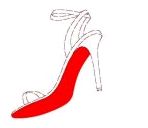The Second Circuit of Appeal of the United States recently released a decision of importance to brand owners and of particular significance to the fashion industry. In Christian Louboutin S.A. v. Yves St. Laurent Am. Holding, Inc. No. 11-3303-cv (2d Cir. Sept. 5, 2012) (Louboutin), the U.S. Appeal Court held that the signature red lacquered sole of Christian Louboutin shoes is entitled to trademark protection.
Two decades prior to this decision, Louboutin introduced the red-soled shoe, which has since become highly coveted and popular in the fashion world. Louboutin sought, and was granted, trademark registration for the Red Sole trademark comprised of a design of a shoe with a lacquered red colour claim for the sole of the shoe, as shown below:

Louboutin then sought to stop another prominent fashion house, Yves Saint Laurent (YSL), from selling its red monochromatic shoe, featuring a red sole that matched the upper portion of the shoe. Louboutin sued YSL for trademark infringement; the district court declared Louboutin's Red Sole registration invalid and held that a single colour can never serve as a trade mark in the fashion industry since colour is a necessary element of fashion design. In the appeal decision, the Court rejected the district court's ruling and affirmed the position that a single colour can serve as a legally protected trademark, including within the fashion industry.
This important U.S. Appeal decision appears to affirm stronger protection to colour marks than the protection currently afforded to such marks in Canada. In Canada, it is not possible to obtain trademark registration of a colour alone, though through extensive use and acquired distinctiveness, a passing off claim may be available to brand owners seeking to protect its signature colour.
The current published view of the Canadian Trademarks Office (TMO) is that colour alone is not registrable as a trademark, following the 1963 decision Parke, Davis & Co Ltd. v. Empire Laboratories Ltd. ((1963) 41 CPR 121 (Ex)) that a colour is not registrable in itself. (The current Trademark Examination Manual IV.2.1, page 98, confirms that colours, alone, are not accepted for trademark registration.) However, the TMO will accept marks that consist of a specific colour applied to a product of particular shape and size. If applied to a specific product, shape, or design, a colour may acquire distinctiveness through use in Canada. The degree of distinctiveness acquired is a question of fact that places a heavy onus on the applicant.
The Federal Court of Canada has confirmed that colour applied to the entire exterior of an article is a valid trademark. In Smith Kline & French Canada Ltd. v. Canada Registrar of Trademarks ([1987] 2 FC 633 (FCTD)) the court reversed the registrar's finding and found that the colour green applied to the exterior of a pharmaceutical tablet of a particular size and shape was a valid trademark. The judge stated that "while distinctiveness, an issue which is not before me here, will always be an important hurdle for an applicant to overcome in obtaining registration of a trade-mark which relies heavily on colour, I would find it difficult to hold that such a trade-mark could never be registrable."
The Supreme Court of Canada has recognised that colour can distinguish a particular manufacturer. In Ciba-Geigy Canada Ltd. v. Apotex ([1992] 2 SCR 120, 44 CPR (3d) 289 (SCC)) the court stated that "the product's appearance or its packaging – shape, size or colour – may be characteristic of a particular manufacturer and have the effect of marking out the product or making it recognizable as his own." This reasoning by the country's highest Court would support a passing off claim in respect of a brand's signature colour.
The Louboutin decision reinforces the U.S. position that a single colour can serve as a trademark only if it has acquired distinctiveness by its owner to the point that the public associates it with a particular brand. To be sure, Louboutin registered the red sole as a trademark on the basis of its strong reputation in the signature red sole, achieved through nearly two decades of extensive use, sales, and advertising of the product. This criterion of acquired distinctiveness echoes the position taken by Canadian courts, requiring an applicant to show that the colour mark has acquired secondary meaning. Moreover, while the Louboutin decision held that there is "no reason that a single-color mark in the specific context of the fashion industry could not acquire secondary meaning...", the Court in fact limited Louboutin's Red Sole Mark registration to only those situations in which the red-lacquered sole contrasts in color with the rest of the shoe, granting YSL the right to sell its all-red shoe. Again, the U.S. court appears to align with the Canadian position that colour can constitute a trademark if applied to a specific product, shape, or design, in this case, the distinctive red sole where the remaining shoe is of a contrasting colour. Nevertheless, brand owners will no doubt use the Louboutin decision to seek broader, more general, protection in the U.S. of a brand's "signature colour." While in Canada such protection of a "signature colour" is not currently a registrable right, a passing off claim could be available to brand owners.
The content of this article is intended to provide a general guide to the subject matter. Specialist advice should be sought about your specific circumstances.

